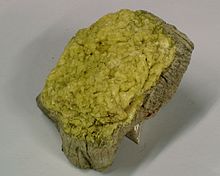Sulfur
Sulfur (or sulphur) is a chemical element with the atomic number 16. It is a brittle, yellow nonmetal with a faint yet distinct odor. Sulfur is found commonly on Earth in elemental form and also in the form of sulfide and sulfate minerals.[1]
Contents
Properties
Chemical
When burned in air, sulfur burns with a blue flame and sulfur dioxide gas is formed. Sulfur will also react readily with the air to form sulfur dioxide when it is molten. Sulfur reacts with chlorine gas to form sulfur chlorides, namely disulfur dichloride and sulfur dichloride, and similarly reacts with bromine to form disulfur dibromide.[2]Sulfur can be digested in a strong solution of sodium hydroxide to form sodium sulfide, a useful precursor to other sulfides.
Physical
Sulfur is a yellow solid under standard conditions. It is brittle; chunks of it can easily be broken by hand. Sulfur will melt at about 115°C, and is a viscous, blood red liquid when molten. Sulfur is insoluble in most common solvents, but is soluble in carbon disulfude, benzene and toluene. There are over 30 allotropes of sulfur, more than any other element. The most common of these is α-octasulfur (S8), which is the form it is almost always seen in. When sulfur is melted and quickly cooled, amorphous polymeric sulfur is formed, which is light brown and has a rubbery consistency. It will only remain as this allotrope for a certain amount of time, varying from a few minutes to a few hours, eventually reverting back to octasulfur.[3]
Sulfur is not soluble in water, but a few organic solvents like xylene and toluene.
Availability
Sulfur can be purchased in fairly pure form on the internet from chemical and industrial companies that are willing to sell to individuals.[4]
Sulfur can also be obtained by the decomposition (through heat) of Cinnabar (Mercury(II) Sulfide), which forms mercury and sulfur. This method is rather dangerous for any amateur, as it produces mercury vapor, which is highly toxic.
Preparation
Sulfur can be prepared by reducing sulfur dioxide with hydrogen sulfide, process known as "Claus process", used in industry to remove hydrogen sulfide. This is a very useful way to neutralize hydrogen sulfide, as opposed to burning it, as it produces elemental sulfur and water and does not generate dangerous gases.
Sulfur can be made from thioethers, which take the form R-S-R':
- R-S-R + 2 H2 → 2 RH + H2S
Projects
- Making polymeric sulfur
- Making gunpowder
- Making sulfides
- Making sulfuric acid
- Make aluminium sulfide
- Make hydrogen sulfide
- Make thermate
- Neutralize mercury and other toxic heavy metal spills
Safety
Elemental sulfur is not toxic, but when burned or melted it produces highly toxic sulfur dioxide gas. Care must be taken to perform any experiments involving sulfur dioxide in a fume hood or an otherwise well-ventilated area.
Sulfides react with many acids to produce extremely toxic hydrogen sulfide, which smells like rotten eggs.
References
- ↑ http://en.wikipedia.org/wiki/Sulfur
- ↑ http://www.sciencemadness.org/talk/viewthread.php?tid=2467
- ↑ Shakhashiri, Chemical Demonstrations, Vol. 1
- ↑ http://www.dudadiesel.com/search.php?query=sulfur
